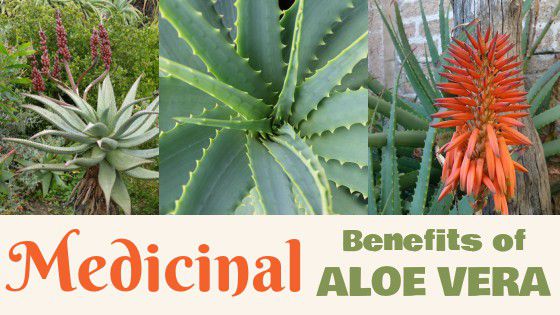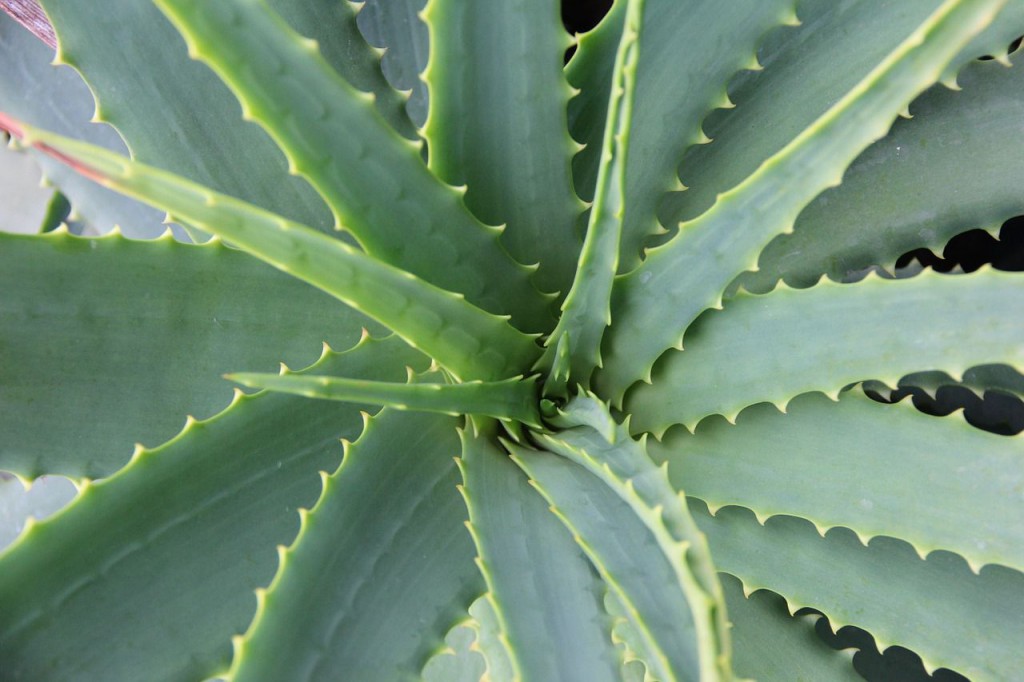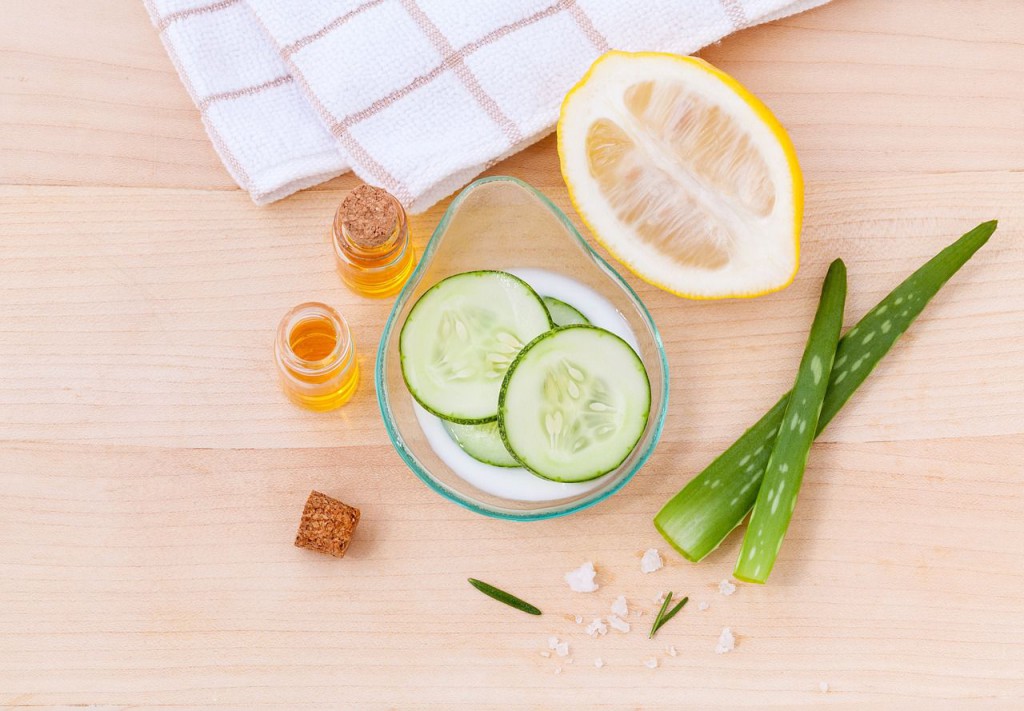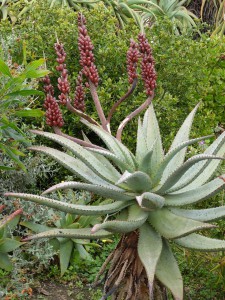The medicinal benefits of aloe vera have been treasured for thousands of years. This awesome plant contains numerous healing properties, the applications are plentiful and nothing short of amazing.

It’s easy to see why ancient Egyptians revered it as the Plant of Immortality, Native Americans described it as the wand of heaven, and over the years it’s been referred to as the wonder plant, plant of life, potted physician, and burn plant to name a few.
It plays a key role in Ayurvedic Medicine to treat a wide range of ailments such as dry skin, minor cuts, wounds and severe burns. Let’s find out what makes this plant so wonderful…
The aloe vera plant is a succulent that grows about one to two feet tall with green to grey-ish prickly, triangular shaped fleshy leaves and flourishes in very warm, dry climates. The leaves hold a bitter, gooey translucent gel. There are many species of aloe, but Aloe Barbadenis Miller (true aloe) displays the most medicinal properties and is most well known as aloe vera.Th
The Layers of The Aloe Vera Leaf
The aloe leaf is made up of 3 layers:
1. Rind: the thick outer protective layer which synthesizes carbohydrates and proteins.
2. Sap: the layer of bitter yellow/translucent gold fluid (latex) directly under the rind that contains glycosides and anthraquinones.
3. Inner Gel: the layer of clear gel that contains around 97-99% water, vitamins, amino acids, fatty acids, sterols and glucomannans.
The rind and sap protect the plants valuable inner gel from damage. As the first line of defense, the prickly tough rind acts as a deterrent for animals. If a leaf is cut or broken the sap seeps through forming a band-aid to prevent further damage and preserve the precious inner gel.
The nutrient profile of aloe is impressive to say the least – with over 200 biologically active components including; vitamins A,C,E and B vitamins, minerals, antioxidants, amino acids and enzymes. As if these aren’t extremely beneficial in themselves, these next three components ramp things up a bit…
Fatty acids in aloe vera have anti-inflammatory, analgesic (pain relieving) and antiseptic properties. Aloe contains beneficial polysacchrides, acemannan in particular, has been shown to stimulate immune system, ease gastrointestinal issues and have an antiviral effect.
Then there are anthraquinones contained in the sap, which I saved for last because they warrant extra attention for a few reasons – the effects are controversial at best.
What About the Sap (Latex) in Aloe Vera?

The anthraquinones found in the sap of aloe act as an analgesic for pain relief, antibacterial and antiviral making them exceptional for external uses on the skin, however when taken at high doses internally, they also exhibit a laxative effect. For this reason the sap is often removed from commercial aloe products. I’m going to address the internal laxative effect later, but for now let’s focus on external use for the skin.
Sap kind of gets a bad rap for the fact that straight from the plant it’s really thick, very bitter, and can have a strong odor. When applied directly from the plant to the skin, it’s really potent stuff and may cause a reaction in sensitive individuals so it is best to apply a little to a small area to test it first.
We’ve been conditioned to know aloe vera gel to be watered down, either clear and odorless or dyed bright green many times with synthetic fragrance added. It’s rare to find an aloe gel for the skin that hasn’t had all it’s goodness filtered out. However, those of us who are savvy about how valuable the sap is appreciate it for the power of the anthraquinones.
Besides aloe vera gel from a live plant at home, the most medicinal aloe gel for burns and other topical uses is a product that doesn’t filter out the valuable sap.
Now, I’m no doctor but I have experienced the difference in healing between sapless aloe and aloe with the sap. For that reason, when it comes to applying aloe vera gel topically for burns and other skin issues I will bypass the watered down, overly filtered, sapless, clear aloe vera gel everyday and stick with my real, golden, sappy aloe any day.
External Benefits of Aloe Vera
When used topically, aloe has the ability to hydrate through three epidermal layers of the skin. The benefit of driving nutrients and constituents deep into the layers of the skin to promote epidermal health not only makes aloe healthy for everyday skin uses but also makes it an effective first aid remedy, when the skin has been damaged.
If you’re not using a live aloe plant, the purity and concentration of a ready made aloe vera gel is important to get the best results. Low quality aloe products are a dime a dozen these days.
Aloe Vera Gel for Everyday Skin Health

Moisturizer: Aloe vera gel can be applied after cleansing your skin to increase the water content, and hydrate it without making it greasy, making it a great moisturizer for oily or acne prone skin.
After Shave: For men, it makes a great after shave to heal nicks.
Acne: Antiseptic, antibacterial, anti-inflammatory properties in aloe make it a great choice for acne or spot treatment.
Anti Aging: Aloe can remove dead skin cells and increase skin elasticity to help prevent wrinkles. In a 90-day study done with women over the age of 45, aloe gel increased collagen production and improved skin elasticity.
Stretch Marks: Since aloe has been shown to increase skin elasticity, when used regularly on areas prone to stretch marks it may prevent them or reduce their appearance.
Scalp and Hair: When it comes to hair, aloe is a wonderful tonic. It’s used to promote hair growth and treat dandruff or itchy scalp by removing dead skin cells from the scalp. It promotes healthy and great looking hair by maintaining the pH balance. Aloe is also a great conditioner that can strengthen your hair and add shine.
Aloe Vera Gel for Immediate Skin Relief:
Speeds Healing of Burns: Aloe vera gel contains anti-inflammatory, analgesic (pain relieving) and antiseptic properties, making it the most common remedy to soothe and heal burns, including sunburns and burns from radiation therapy, and prevent scarring.
Heals Wounds and Bites: The same properties that make aloe great for burns along with astringent, antibacterial and antimicrobial properties to prevent infection make it useful for minor cuts, scrapes, and insect bites. It is advised to consult with your health care practitioner before applying aloe to deep or open wounds, or skin ulcers.
Calms Rashes and Skin Irritations: Aloe exhibits an antipruritic effect by blocking histamine production to relieve or prevent itching, making it a remedy for rashes, eczema and psoriasis.
Treats Cold Sores: Studies have shown aloe vera gel to reduce the pain of cold sores, or any mouth sores, and help them to heal faster.
Herpes Remedy: The anthroquinone in aloe hinders both herpes simplex virus types 1 and 2. Aloe vera cream was effective at stopping 70% of genital herpes outbreaks in participants of a 1999 study. For best results, aloe gel or cream should be applied three times a day at the first sign of an outbreak and continued for at least two weeks.
Internal Benefits of Aloe Vera
Taken internally, aloe vera juice can be equally as soothing. It’s rich nutrient profile provides a magnitude of healing potential for the body. There are, however some important things to know before drinking aloe juice internally. Coming back to the sap (latex) I touched on earlier.
Whole leaf aloe vera juice contains latex which can have a laxative effect, and can cause gastrointestinal discomfort. I say can since the anthroquinone, aloin in the latex can have a laxative effect in high doses. Which is why it’s important to know the amount of aloin in a ready-made whole leaf aloe vera juice.
That being said, unfiltered aloe contains approximately 10,000 part per million of aloin and there are some aloe juices that contain a very low amount of aloin, less than 1 part per million. There are some benefits of the whole leaf, it contains both high and low molecular weight polysaccharides – the inner fillet contains only high molecular weight polysaccharides.

However, if you’re not comfortable with drinking whole leaf, fortunately, with easy access to aloe vera juice made with only the inner fillet it’s easy to be on the safe side and go with it instead. Especially if you have a sensitive stomach or digestive system, opt for inner fillet.
Bottom line: To experience maximum health benefits, choose as close to 100% aloe juice from either the whole leaf with very low aloin, or the inner fillet – with no water added, not overly filtered and preservative/additive free.
And don’t be duped by the myriads of “aloe drinks” you see in the markets now, they aren’t nearly as effective as the concentrated juice.
Aloe Vera Juice for Everyday Internal Health:
Supports Immune System: The nutrient rich profile and constituents in aloe vera juice support a strong immune system.
Digestive Health and Regularity: Aloe juice has a soothing effect on the esophagus and the entire length of the digestive tract, it supports proper functioning and soothes the lining of the esophagus and stomach when irritated by heartburn, acid reflux, or ulcers. Enzymes help with digestion and regularity.
Reduces Inflammation: Antioxidants in aloe vera juice provide anti-inflammatory benefits that have been shown to reduce general inflammation in the body including, gut and joint inflammation, and can be helpful for arthritis inflammation and pain both internally, and applying it topically to inflamed areas. Acid imbalance can cause inflammatory conditions and aloe promotes healthy pH balance.
Promotes Oral Health: When applied to gums and used as a mouthwash, studies have shown aloe vera to reduce plaque growth that causes gum disease and tooth decay, by killing bacteria and fungus within the mouth. Note: If rinsing your mouth with aloe, do not swallow it as it will be full of bacteria, spit it out instead.
Increases Absorption of Nutrients: When taken at the same time as daily vitamin supplements, studies have shown aloe vera juice to improve the bioavailability of certain nutrients by as much as 210%.
Supports Healthy Circulation: Aloe Juice supports circulation of blood throughout the body by helping to increase the size of the capillaries, allowing blood to flow more freely. This is especially important for a healthy functioning heart. Plant sterols in aloe also may help to lower cholesterol levels.
Supports Blood Sugar: Aloe can be used as a preventative to support healthy blood sugar and reduce blood glucose levels. Although research thus far has produced promising results, more is being conducted regarding the potential of aloe vera juice to treat symptoms of diabetes.
Aloe Vera Juice for Immediate Internal Relief
Relieves Constipation: Whole leaf aloe vera juice can come to the rescue when you really need to get things moving again.
Relieves Asthma: The combined anti-inflammatory and immune-stimulating effects of enzymes, acemannan and aloin, work to eliminate mucous and inflamed tissue, opening up the airway. For immediate relief, mix 1 tablespoon of pure aloe vera gel (more concentrated than juice in this case) in boiling water and inhale the steam. For everyday asthma support, drinking aloe vera juice three times a day can help.
Where Can I Find Quality Aloe Vera?
You can grow your own aloe vera plant(s), or sometimes you can purchase fresh leaves from your local farmers market or natural foods market. Here’s a quick video showing how to fillet fresh aloe vera.
If that’s not your thing, fortunately there are some quality aloe products available in most natural foods markets, or online. A word of caution though, it’s difficult to find high-quality products in drug stores or supermarkets.
Many manufacturers cut corners in the processing methods of aloe vera with things like crushing, grinding, over filtration and over heating which can result in a poor quality product containing little to no active ingredients in the end, minimizing the health benefits of the raw aloe vera they began with.
As a precaution, look for The International Aloe Science Council (IASC) certification which validates the quality and quantity of aloe vera in approved commercial products.
I use this aloe vera juice backed by clinical studies, with the IASC certification seal and made with 99.7% certified-organically grown aloe vera. It’s from the whole leaf with a low aloin content (less than 1 part per million).
The taste is slightly bitter, if aloe doesn’t taste bitter it’s been watered down, so I know this is how real aloe should taste. You can always mix it in juice if you prefer. They also offer this aloe vera juice inner fillet only, a little less bitter tasting.
To find out what my favorite aloe vera gel for topical use is, you can visit my review here.
Have you experienced the healing power of aloe vera? Share your comment below!

I’ve always seen “with Aloe Vera” on commercial products, but never gave it much thought. I could definitely see how this wouldn’t be beneficial, just from knowing about the poor quality of most everything these days. What you said about stripping down something good into something that is largely manufactured is such an age old dilemma. Take fruit juice for instance. Added sugar, added preservatives, no health benefit. 1 cup of OJ is the equivalent of like 4 oranges or something absurd. Who eats that many oranges? Lol.
But let me digress, a great article here! I am really interested in incorporating aloe vera into my life. Have you used Coconut oil? Also great stuff.
You’re so right on the age old dilemma of poor manufacturing processes, Stu. Glad you enjoyed the read, and I’m happy I could spark your interest in the many medicinal benefits of aloe vera. I love coconut oil also, I use it for tons of things. In fact, you may want to check out my post about it :) Thanks and take care!